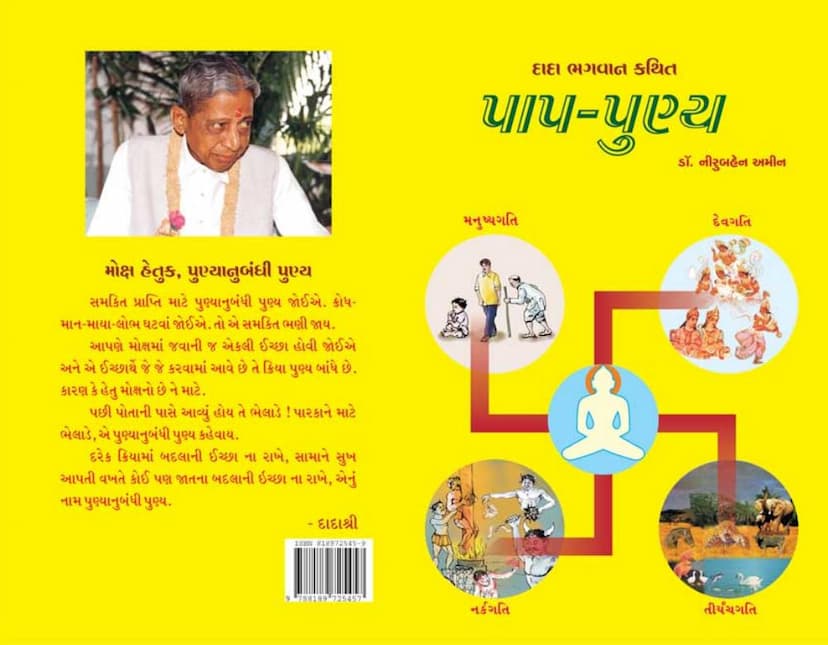Pap Punya
Added to library: September 2, 2025

Summary
Here's a comprehensive summary of the Jain text "Pap Punya" by Dada Bhagwan, based on the provided pages:
Overall Theme:
The book "Pap Punya" (Sin and Merit) by Dada Bhagwan, published by Dada Bhagwan Foundation, delves into the fundamental concepts of sin (pap) and merit (punya) from a spiritual and practical perspective. It aims to simplify the understanding of these terms, which are deeply ingrained in Indian culture and spiritual discourse, and provide clear guidance on how to navigate them for ultimate liberation (moksha).
Core Teachings:
-
Simple Definition of Pap and Punya: Dada Bhagwan offers a straightforward definition: "Giving happiness to others builds punya (merit), and giving sorrow to others builds pap (sin)." This simple principle is presented as the key to understanding the essence of dharma and adharma.
-
The Role of Intent (Hetu): The ultimate intention behind an action is crucial. Actions performed with the sole desire for moksha (liberation) create punyanubandhi punya (merit that leads to liberation). If the motive is worldly happiness, the punya is temporary and fades away.
-
Punyanubandhi Punya for Moksha: To attain moksha, mere punya is not enough. It must be punyanubandhi punya—merit that is bound with the intention of moksha. This requires:
- A reduction in anger, pride, deceit, and greed (kashayas).
- Generosity, sharing what one has with others.
- Performing actions without expecting any return or reward.
-
The Illusion of Cause and Effect: The book emphasizes that the circumstances we face—good or bad—are not dictated by external forces but are the result of our own past and present punya and pap. There is no external controller; our karma is the driver.
-
Distinction Between Relative and Real Dharma:
- Relative Dharma (Vyavahar Dharma): This is about accumulating punya for worldly happiness and creating a foundation for spiritual progress. It involves good deeds and avoiding bad deeds.
- Real Dharma (Aatmadharma): This is the true, inherent nature of the soul. It transcends both punya and pap, which are considered attributes of the ego (ahankar). The goal of real dharma is moksha, which is achieved by realizing the true self.
-
The Binding Nature of Karma: As long as the ego ("I am doing") persists, karmas are bound. Punya binds "good" karmas, and pap binds "bad" karmas. Until the distinction between "mine" and "not mine" is realized, one continues to bind karma.
-
Types of Karma: The text categorizes karma into four types:
- Papanubandhi Pap: Committing sin and continuing to create new sin, finding pleasure in it.
- Punyanubandhi Pap: Experiencing the consequences of past sins but building merit through righteous conduct and good samskaras. (Though less common in this era).
- Papanubandhi Punya: Experiencing the results of past merit but binding new sin through one's actions and desires. (This is prevalent in the current era).
- Punyanubandhi Punya: Experiencing the results of past merit and continuing to build new merit, leading towards ultimate liberation.
-
The Purpose of Wealth (Lakshmi): Wealth is a result of punya. However, wealth gained through wrong means (pap) leads to negative thoughts and further sin. True wealth, gained through honest means and used for good, brings happiness. Wealth is a tool, and its impact depends on the intention and actions associated with it.
-
The Role of Knowledge (Gnan): True knowledge, the knowledge of the Self, is the key to breaking free from the cycle of punya and pap. Without this knowledge, one remains bound by the ego and continues to create new karmas.
-
Pratikraman (Self-Correction): When a mistake or sin is committed, immediate pratikraman (repentance and resolution to not repeat) is essential. This involves asking forgiveness from the Self within, feeling genuine remorse, and making a firm resolve to change.
-
The Nature of Suffering: Suffering (dukh) is the result of past pap. Even young children experience suffering as a consequence of their past karmas. Conversely, happiness and peace are results of past punya.
-
The Law of Karma is Absolute: The universe operates according to strict laws of karma. There are no shortcuts or loopholes. Everything that happens is a consequence of our own actions. Blaming others or external forces is a sign of ignorance.
-
The Importance of the "Tendency of Mind" (Buddhi no Aashay): The underlying intention and desires in one's mind determine the kind of karma that is bound. Focusing the mind on spiritual pursuits (dharma) leads to punya, while focusing on worldly desires and selfish actions leads to pap.
-
The Nature of Moksha: Moksha is the state of liberation, beyond both punya and pap. It is achieved by shedding the ego, realizing the true nature of the Self, and becoming free from the cycle of birth and death. The path to moksha is through Self-knowledge, attained from a Gnani Purush (Self-realized being).
Key Takeaways:
- Simplicity in Spiritual Understanding: Dada Bhagwan's teachings are characterized by their directness and simplicity, making complex spiritual concepts accessible to everyone.
- Focus on Intent and Action: The book emphasizes the importance of pure intention and righteous actions as the foundation for spiritual progress.
- Self-Responsibility: Ultimately, individuals are responsible for their own destiny, shaped by their own karmic patterns.
- The Ultimate Goal is Liberation: While punya can lead to temporary happiness and favorable circumstances, the true aim is moksha, which requires transcending the duality of punya and pap.
In essence, "Pap Punya" provides a roadmap to understand the intricate workings of karma and guides the reader towards a life of spiritual awareness, ethical conduct, and ultimately, liberation from the cycle of suffering.